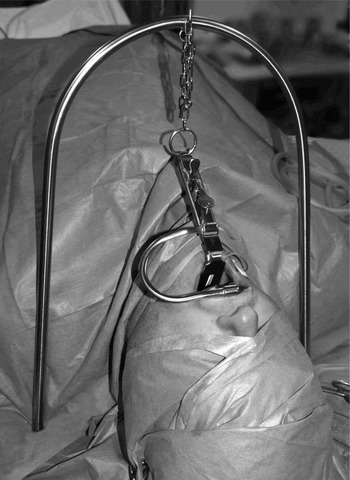Introduction
Prior to the 1950s, anaesthetists manually supported the mouth gag during tonsillectomy. In 1951, Draffin published a method of suspending the Boyle–Davies gag on a bipod consisting of two rods with multiple rings.Reference Draffin1 The method proved a success and was widely adopted. In 1991, Chevretton and Morrison described a variant based on the design of a pitchfork.Reference Chevretton and Morrison2 Those who use the Draffin bipod will have experienced its problems encountered during positioning, including slipping, instability, under- and over-extension, and obstruction of the oral endotracheal tube particularly when treating paediatric patients.
The ‘Kiwi hoop’
The ‘Kiwi hoop’ is an alternative means of suspending the Boyle–Davis gag during tonsillectomy (Figure 1). The device is manufactured by the Christchurch Hospital precision engineering department, using medical grade stainless steel tubing and chain. After insertion and opening of the gag, the Kiwi hoop is positioned as shown in Figures 2 and 3. The gag is then held in the appropriate plane, using the chain, which has a ring to fit the Boyle–Davies gag. The chain is suspended on the hook of the Kiwi hoop.

Fig. 1 The Kiwi hoop.

Fig. 2 The Kiwi hoop being positioned (adjustable in the vertical plane).

Fig. 3 The Kiwi hoop and Boyle–Davis gag apparatus in position on a patient.
The Kiwi hoop has a number of advantages over the more widely used Draffin bipod. Firstly, the device has multiple adjustments in the vertical plane, whereas Draffin's rods have only four position options, which can cause problems in the safe positioning of young children's necks (particularly those with potential cervical spine instability, e.g. Down's syndrome patients). Using Draffin's rods can obstruct endotracheal tubes or over-manipulate them, as only four positioning options are available; The Kiwi hoop has a broader base and thus is more stable on the operating table. There has been no report of breakage of chain or failure of device during tonsillectomy.
Conclusion
The Kiwi hoop, as described, has been used in Christchurch Hospital for many years. Others may also find it a useful alternative to Draffin's bipod.





